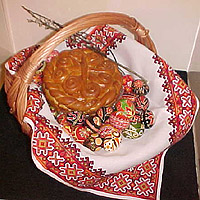
203 Second Avenue (bet. 12th & 13th Sts.) New York, NY 10003
Wed. thru Sun. 1-5PM (212) 228-0110
e-mail: UkrMus@aol.com * www.ukrainianmuseum.org
News from and about Ukraine & Ukrainians: Ukrainian Community Press Releases
getLinks();
?>
BRAMA, July 14, 2000, 4:30pm EDT

|
The Ukrainian Museum 203 Second Avenue (bet. 12th & 13th Sts.) New York, NY 10003 Wed. thru Sun. 1-5PM (212) 228-0110 e-mail: UkrMus@aol.com * www.ukrainianmuseum.org |
The Preservation of an Ancient Tradition
The Ukrainian Museum's Annual Pysanka Exhibition

Easter Basket on display at The Ukrainian Museum |
The Ukrainian Museum’s annual pysanky (Ukrainian Easter eggs) exhibition, Pysanka, Safeguarding an Ancient Tradition is on display and will continue through July 31, 2000. This year the exhibition is dedicated to several contemporary artisans who were instrumental in the preservation, revival, and popularization of the art of the pysanka.
The exhibition presents close to 300 pysanky of such known artisans as Jaroslava, Romana and Natalka Bachynsky from Montreal, Canada, Tania Osadca from Troy, Ohio, Zenon Elyjiw of Rochester, New York, Luba Perchyshyn from Minneapolis, Minnesota, Ihor Slabitsky from Rhode Island, Yaroslava Surmach Mills from West Nyack, New York, and Sofia Zielyk of New York City.
Thanks to their work and efforts, where the pysanka was unknown, it was introduced, where it was forgotten and abandoned, it was rediscovered and revived and where it was neglected and ignored, it was given back its place of honor as a symbol of rebirth, power, magic and beauty.
Although each of the participating artisans have their own story to tell—how they developed their interest in the pysanka art form, and why they persevered in promoting it—there is an underlying force which unites them all. This force is imbedded in their Ukrainian roots and in their understanding of the importance of safeguarding and perpetuating the ancient traditions of their people.
In acknowledging their contribution in this work, the Museum is at the same time paying homage to Ukrainian culture and the numerous, mostly anonymous folk artisans, who for centuries lived according to their cultural traditions and preserved them in all their vibrancy until our time.
The Ukrainian tradition of writing pysanky reaches back to antiquity. In attempting to understand creation, ancient people throughout the world developed myths in which the egg symbolized the source of life, the sun, and the universe. It appeared in mythologies of ancient civilizations, in various creation myths, and in many legends and customs. In Ukraine it was part of the pre-Christian tradition. With the advent of Christianity (in 988 AD), the decorated egg (pysanka) and the customs associated with it, were incorporated into the Christian religion. The pagan celebration of the coming of spring—the rebirth of nature after the long winter—gained a new Christian meaning—the Resurrection of Christ. Thus, the pysanka became permanently associated with Easter.
The symbolic ornamentation of the pysanky consist mainly of geometric motifs, with some animal and plant elements. The most important motif is the stylized symbol of the sun, which is seen as a broken cross, triangle, an eight-point rosette or a star. Other popular motifs are endless lines, stylized flowers, leaves, the tree of life, and also some animal figures such as horses, stags and birds. The Christian influence brought elements such as crosses, churches and fish.
The most popular method of decorating pysanky is the use of the wax resist method or batik. A specialized instrument called the kistka, ryl’tse, or pysal’tse is used to write the design. The dyes used in decorating pysanky also had a symbolic meaning. Red symbolized the sun, life, joy; yellow stood for wealth and fertility; green was the symbol of Spring, plant life, etc. In the not too distant past artisans prepared their own dyes, using natural products such as the bark of oak or ash trees, twigs of sour apple trees, saffron or willow leaves. Today chemical dyes are used.
It took a long time for the Ukrainian pysanka to develop and achieve perfection. Contemporary artisans continue to employ the ancient symbols and traditional colors on the egg,. The pysanka, however, is no longer considered to be a talisman, but a beautiful folk art object that is still part of an ancient Easter tradition and is included with other food that is blessed on Easter Sunday. It is still exchanged as a token of love and friendship.
More Community Press Releases -- Click Here
Comments and observations about this article and other news
may be posted to the Press Comment Board
|
|
|